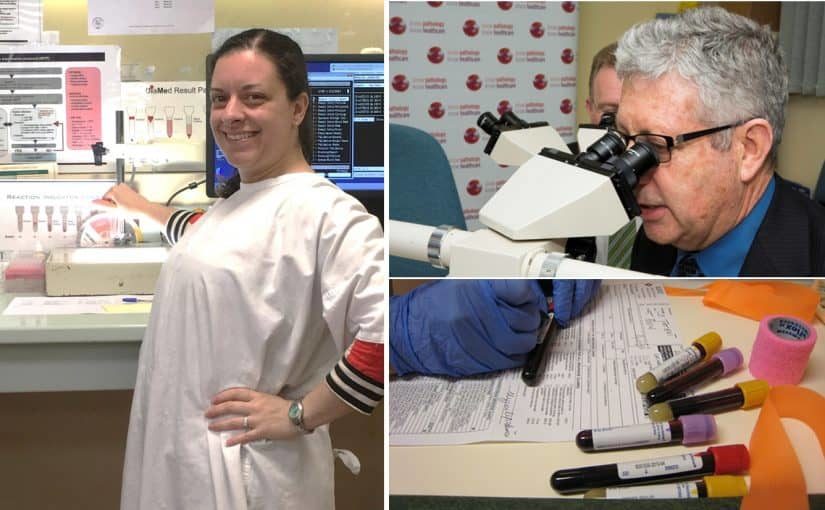To celebrate International Pathology Day this month we take a closer look at some pathology professionals to see why they chose their job and what they love about it.
Medical Scientist – Alicia Thompson
Alicia had been interested in science since high school and after completing her studies went to work as a food scientist testing dairy products for safety. Alicia enjoyed the work but always knew she wanted to move into medical science;
“I liked the fact there was a human being at the end of a test”. Alicia said, “After nine years I still get a rush out of my work. It’s stressful when we’re really busy but I thrive off the adrenaline rush. The phone rings and it could be anything from a car accident with multiple traumas needing blood transfusions, or a critically ill baby needing a test for an infection around the brain. Every day you’re jumping into the unknown.”
When asked about memorable moments Alicia said:
“There are lots of small moments that have made me proud of my work over the years. Often if a patient is going into surgery I’ll try to prepare in advance for potential requests from the surgeons. A couple of times the patient was bleeding heavily and they needed more red blood cells. When I’ve been able to pre-empt the request from the surgeon and have everything ready to go immediately they’re very impressed. It’s not often we get a ‘thank you’ but on those occasions the anaesthetist has called me up directly to thank me for my role in helping to save a patient’s life. That feels pretty good!”
Pathologist – Dr David Clift
David says that during his medical training he was at first intending to become a surgeon.
“As an undergraduate student I didn’t understand the importance of pathology but as a resident in a hospital working for a cancer surgeon, and also working in a haematology department, I got to see how important and interesting pathology was.”
David says that his area of pathology is incredibly valuable and interesting. He enjoys the personal diagnostic challenges that are different every day but also knows the importance of being able to help another medical practitioner to provide a more personalised service. He says that pathologists also see rare conditions more often than many other practitioners, which helps them to provide better advice to surgeons.
One case of an uncommon disease that David diagnosed helped safeguard a group of children:
“One of the most dramatic cases where my work made a difference was when I made a diagnosis of a serious infectious disease at autopsy. It was meningococcal septicaemia in a young child; I made the diagnosis in the morning and public health measures were being taken by the afternoon for a whole grade one class. I have grandchildren at this age so it felt good to work together with microbiology and public health to help protect these children.”
Collection Services Manager – Peta Martin
Peta started as a lab technician in the Royal Australian Air Force and while working there trained as a medical scientist. Peta said that working as a medical scientist in the RAAF was different from her later roles in the civilian world;
“We were working with a closed population of people who were generally healthy so a lot of what we did was screening tests, but we also had hospitals and field medical units. We did everything from collection to ward rounds and working in the lab.”
The thing Peta likes most about her current role as a Collection Services Manager is the direct contact with patients. “We’re the face of pathology, the people the patient remembers,” she said.
A particular moment which is a good example of this personal touch happened during a time Peta worked in a country setting;
“We had a lady with a condition called cold agglutinins causing a haemolytic anaemia* – once the blood samples are collected, as soon as the blood starts to cool the red cells agglutinate (clump together) resulting in many tests being impossible to perform on those samples. Everything had to be warmed up for this patient; from the bleeding room to the tubes, the collection devices and needles. Watching my staff go out of their way to help this lady and knowing we were helping her in her crisis moment was pretty wonderful.”
*Hemolytic anemia is a condition in which red blood cells are destroyed and removed from the bloodstream before their normal lifespan is over

